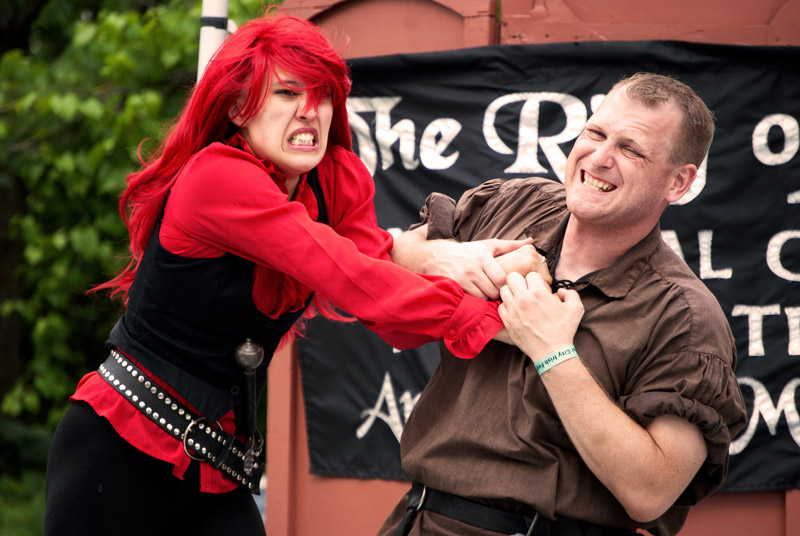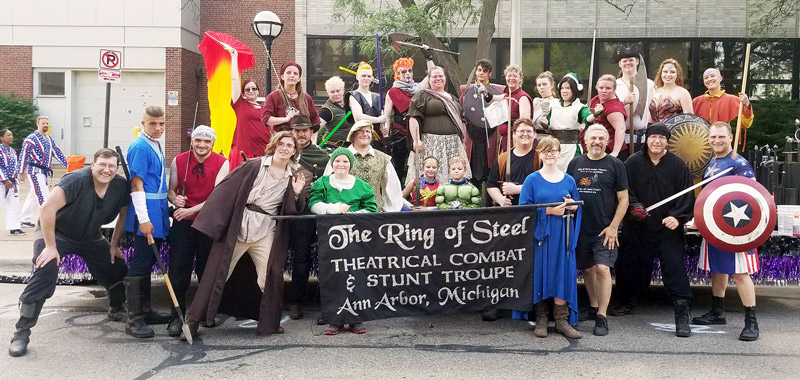I live a double life of sorts – during the day, I work in the Logic office managing and delivering web and mobile projects to clients all over the U.S. In the evenings and on weekends, I am a swordfighter and stuntwoman; I teach at, train with, and perform for Ring of Steel Action Theatre and Stunt Troupe, an Ann Arbor-based organization dedicated to the art of stuntwork and telling the story of a fight without actually hurting anyone. For at least 8 hours a week, 50 weeks a year, I am busy battling away with a rapier or dagger (or both), swinging a broadsword, throwing myself off scaffolding into crash pads, and flying high on wires. And I sometimes do all of that dressed as a superhero, Jedi knight, pirate, or a warrior from the local Renaissance Festival.
Oh, and on top of that, I am also an aerial silks artist.
(Not-so-secret) Double life, indeed.
Although there doesn’t seem to be an immediate connection between project management at a software development company and running off with the circus every weekend, there is more overlap than you think. Here are 9 lessons I have learned about working with clients from sword fighting and the circus.
1. They are your partner, not your opponent.
In stuntwork and the portrayal of fictionalized violence, the people whom you are “fighting” aren’t actually your enemy. That’s the key difference between martial arts and stunt action – martial arts teaches a practitioner to cause maximum damage to an attacker in the most efficient manner possible, whereas stunt action is about the story of a fight between the protagonist and antagonist, and not actually injuring anyone. The people we fight are not our opponents; they are our partners, and it is this partnership that creates a thrilling action scene.
The same is true when working with a team of developers or a client. Everyone has the same objective: make the end solution great to help the client boost their business. The people you work with, from the project manager to the consultants, designers, developers, product owner, and stakeholders, are all your partners in this endeavor and should be treated as such. Collaboration is key to making the project become a reality.
Communication is equally important. When choreographing fight sequences for a scene, there is inevitable friction between the fight choreographer and director because of conflicting ideas. In the heat of the moment, it is difficult to remember to collaborate. Similarly, for development projects, visions can be hard to communicate with the client and project manager, and the project manager to the other solution team members. When that happens, take a second to step back, maybe bring in a third-party who can better express what is trying to be said, and regroup to direct your energy back to the ultimate goal: developing a successful project.
2. Show where you’re going to go.
Transparency is a key component of successful project management – if you openly share with your client how the project is going, issues that are going things to not go smoothly, pros and cons different solutions, etc, they will appreciate you more. Being transparent means letting folks know what’s going on.
The same goes for stage combat. Again, the people we fight are our partners, not our opponents. This means I don’t want to “fake out” my partner, surprise them, or cause them to jump. We telegraph every one of our moves – we wind up for an attack, pull the elbow back dramatically before we throw a punch, and point our swords at the target area before we lunge. No, in a real fight on the streets you don’t want to actually show your enemy what you’re doing, lest you actually want to get your butt kicked. But when you’re working with friends and colleagues, you show them your next attack before it actually happens. This also allows the fight-illiterate audience (let’s be honest, no one gets into duels with swords these days anymore) to follow and appreciate the fight.
3. If it hurts, you’re doing it wrong.
There is a difference between pain and discomfort – discomfort is fine because that means you’re trying something new and different that you’re not used to. (Yay for trying things outside your comfort zone!) But pain is an indication that something has gone terribly wrong.
In aerial silks, discomfort and bruises in concerning areas are a fact of life. You’re frequently wrapping yards of thin, tricot nylon fabric around your body; suspending, falling, swinging, and spirling bodies into and out of various positions; performing intricate gymnastics and acrobatics while suspended in the air without the use of safety lines; and generating close to 1,000 pounds of force with drops. Discomfort and bruising is part of the learning process. But we all know that if something actually hurts, it should be revisited.
View this post on Instagram
The same can be said of software development. We want to challenge our engineers to push themselves to solve interesting, and complex problems to create unique, robust solutions for our clients, but if the development process ever becomes a painful experience, the developer should stop, take a step back, reassess, and possibly find a workaround.
4. There is no such thing as being over-prepared.
When you’re at a festival or performing for a convention, there are a million moving pieces just to make the event happen smoothly. At Ring of Steel, we travel with our own stage, sound and lights, theatrical props, tools, games for event attendees, and kettle corn popper. With that much equipment plus another dozen or more performers, planning, coordination, organization, and communication are an extremely vital part of being a professional performance troupe. (No one wants to be the one to drive back and forth from an event 1+ hours away just because something important was forgotten.)
In order for a project to run smoothly, it also doesn’t hurt to over-prepare. The more organization, planning, and communication that happens between the development team and the client, the better the expectations are set and (in an ideal world) the easier it’ll be to deliver the project.
However…
5. Plan all you want, but something will always go to sh*t.
Okay, so I wish that over-planning always meant nothing bad will happen. But in reality, when you’re working with artists (as is the case with Ring of Steel) or clients (especially the non-tech savvy ones), a train wreck is bound to happen. It’s just a matter of when.
The trick to handling crises is not to get hung up on “This didn’t go according to plan!!”. Planning is great, but it is equally important to know how to adapt on the fly as emergencies come up. Once the emergency has been dealt with and the event (or project) is behind you, take time for a post-mortem (also known as a post-production meeting, after action review, or retrospective) – reflect on what worked, what didn’t work, and how to improve for next time.
6. The presentation is sometimes more impressive than the technical complexity.
Everyone is, without a doubt, always impressed by the splits. Or when a performer drops seemingly uncontrollably several feet through the air. Or when a small girl takes down a larger man.
But see, the secret is that none of these are particularly difficult to do. What makes them so impressive is the showmanship – the flair, the pizzazz, the experience of witnessing something really, really cool.
Any UI/UX designer will tell you that just because there is a solution to a problem doesn’t mean the solution is a great idea or a successful one. Design should create pleasure (trigger users to fall in love with the product or service), be effortless (be easy for users to find things with minimal energy), be delightful (create great experiences). As Aaron Levie, CEO at Box said, “‘Does it better’ will always beat ‘did it first’.”
7. Don’t be afraid to shout and cheer with excitement.
In some cultures, audiences are very vocal in expressing their enthusiasm during good performances. It is believed that when the audience cheers and claps to show their appreciation for a performer, this causes the performer to up their game, which in turn causes the audience to show more appreciation. Based on the Arabic concept of tarab, this positive feedback loop can be applied to any kind of performance that emotionally moves the audience, such as a concert, dance, or theatrical show.
Audiences at festivals are surprising reluctant to show their enthusiasm during a circus act for a couple of reasons – 1) American etiquette culture specifies that audiences should wait politely until a song, performance, or act is finished before clapping; and 2) audience members have confessed they are afraid of distracting the performer if they cheer or clap.
I won’t be the first circus performer to say this: performing in front of a dead silent (or politely quiet) audience is unnerving, and then you start doubting the quality of your act. The lesson we always try to teach audiences at festivals is this: don’t be afraid to be excited when something cool happens.
I can extend this lesson for project managers and clients to software development. Don’t be afraid to compliment developers when they do a great job, when clients get excited about the project, or when a difficult problem is resolved. This unabashed expression of emotion will motivate all parties involved to perform better, which generates more compliments and enthusiasm, and results in a beautiful positive feedback cycle.
8. Share your passion with others.
If you’re not particularly knowledgeable about a topic, if you have no frame of reference for what is “good” vs “bad”, it is challenging to get excited when you’re met with something “great”. Everyone has gone to an art museum, looked at a famous work by a well-known artist, and privately thought to themselves “I don’t get it. What makes this so good?”
Not everyone is can really appreciate excellent sword fights or complex acrobatic acts. But if you take the time to teach the audience why what they saw is impressive, they will gain a greater appreciation for the art the next time they view it.
The same goes for software development. Educate clients about what modern best practices are and why they are considered best practices (and why they should forgo that outdated idea they had when you two first met), and they will be able to recognize and appreciate your final solution that much more.
9. The learning never stops.
No matter how good of a performer or stuntperson you are, there’s always room for improvement. The process of one’s training – the strengthening of the body and the mind, the learning and the perfection of one’s skills – never ends. There isn’t anyone who knows everything and doesn’t have anything else to learn or improve on.
Clients often forget that this continued work also translates to the solutions we deliver. No matter how simple or robust your application is, it requires ongoing maintenance and support. A lot of people don’t like the idea of continuing to pay a development company more money to upkeep their application, but the fact is if maintenance ceases, the app will fall behind and eventually become obsolete.
The learning, practice, maintenance, and work never stops. For some people, this is a difficult truth to swallow. But ultimately it will make you, as a person and a company, and your services better than before.
Jennifer Pan is a mild-mannered digital solutions lead at Logic Solutions by day and a daring stuntwoman, swordfighter, and aerialist by night. She is known to run off with the circus on the weekends. Her attempts to convince her marketing coworkers to join her for aerial silks classes have been unsuccessful.



